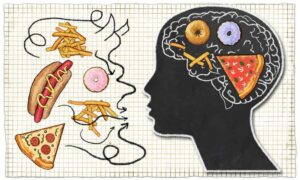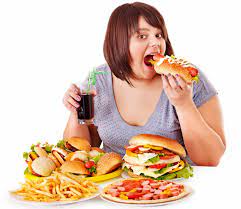If you think someone you know might have an eating disorder, it’s important to learn about the different types of disorders and how to recognize them. Eating disorders can be very harmful to a person’s physical and mental health, so it’s crucial to get help as soon as possible. In this blog post, we will discuss the most common types of eating disorders. Also, we will provide information on how to get help for these types of disorders.
Contents
What Are Eating Disorders?
 Eating disorders are described as serious and often fatal illnesses that are associated with disturbances in eating behavior. Eating disorders affect people of all ages, genders, and backgrounds, but they are most common among adolescent girls and young women.
Eating disorders are described as serious and often fatal illnesses that are associated with disturbances in eating behavior. Eating disorders affect people of all ages, genders, and backgrounds, but they are most common among adolescent girls and young women.
Moreover, eating disorders can have severe and long-lasting effects on a person’s physical and mental health. Studies have found that people with eating disorders often have low self-esteem and are overly concerned about their body weight and shape. They engage in unhealthy behaviors such as crash dieting, purging, and excessive exercise.
The types of eating disorders are actually more numerous than most people realize. So, it is though important to be aware of the different types in order to identify them and get the necessary help.
What Are The Types Of Eating Disorders?
Eating disorders are considered a group of mental disorders that are characterized by an abnormal relationship with food. This can manifest in a number of ways, including overeating, undereating, or unusually picky eating habits. Eating disorders often have serious consequences for a person’s physical and mental health.
There are five main types of eating disorders, these include:
Anorexia Nervosa
This type of eating disorder is characterized by very low body weight and an intense fear of gaining weight. People with anorexia nervosa often restrict their food intake and may also engage in excessive exercise or purging behaviors.
Generally, this type is developed in adolescence or early adulthood and is more common in females. Anorexia nervosa has the highest mortality rate of any mental disorder, with estimates ranging from five to 20 percent. People with this type of eating disorder feel compulsively driven to be thin and see themselves as overweight, even when they are not.
Some of the common symptoms of anorexia nervosa are:
- Intense fear of gaining weight or becoming fat
- Distorted body image, feeling overweight even when underweight
- Restrictive eating habits, such as Cutting out entire food groups
- Excessive exercise
- Engaging in purging behaviors, such as self-induced vomiting or misusing laxatives
Anorexia nervosa is more about controlling weight through starvation and less about the food itself. Individuals suffering from anorexia nervosa will often create rules and rituals around eating. Such as only eating a certain number of calories or types of foods. This can lead to severe malnutrition and even death in severe cases.
Bulimia Nervosa
Bulimia nervosa is described as a serious, chronic, and potentially life-threatening eating disorder. Individuals with bulimia nervosa engage in recurrent episodes of binge eating followed by purging behaviors.
Bulimia nervosa affects women more often than men and typically begins in adolescence or early adulthood. Some common symptoms of bulimia nervosa may include:
- recurrent episodes of binge eating
- feeling out of control during binge-eating episodes
- extreme concern with body weight and shape
- unhealthy compensatory behaviors after eating, such as purging, fasting, or excessive exercise
- frequent changes in weight
- a missed menstrual period in women
- electrolyte imbalance and dehydration
- gastrointestinal problems.
These symptoms of bulimia nervosa are often accompanied by emotional and behavioral symptoms, such as:
- depression
- anxiety
- mood swings
- social withdrawal
- irritability
These are only some of the symptoms associated with bulimia nervosa. If you or someone you know is displaying any of these signs, it is important to seek professional help. Bulimia nervosa is a serious and complex condition that requires specialized treatment. With proper care, however, full recovery is possible.
Binge Eating Disorder
 It is considered the most prevalent subtype of eating disorder in the U.S., and is characterized by episodes of overeating or “binging.” A person with BED frequently eats large amounts of food in a short period of time and feels that their eating is out of control. And has associated distress about their bingeing behavior.
It is considered the most prevalent subtype of eating disorder in the U.S., and is characterized by episodes of overeating or “binging.” A person with BED frequently eats large amounts of food in a short period of time and feels that their eating is out of control. And has associated distress about their bingeing behavior.
Despite these negative consequences, people with BED continue to binge eat. Because it provides temporary relief from anxiety, depression, or other negative emotions. But people are more likely to seek help when they realize that their binge eating is impacting their quality of life.
There are a few key characteristics that are associated with Binge Eating Disorder:
- Eating more rapidly than usual during a binge
- Eating until feeling uncomfortably full
- Large amounts of food even when not physically hungry
- Eating alone because of feeling embarrassed by how much one is eating
- Feeling disgusted with oneself, depressed, or very guilty after overeating
These are some negative consequences associated with Binge Eating Disorder:
- Weight gain and obesity
- Type II diabetes
- High blood pressure
- High cholesterol
- Heart disease
- Joint pain
- Sleep apnea
While there are many negative consequences associated with Binge Eating Disorder, it is important to note that people with this disorder can recover. They just need to be focused and committed to seeking treatment.
Rumination Eating Disorder
This is a disorder where a person regurgitates their food. This can happen right after eating or hours later. The person may chew the food again or just spit it out. People with this disorder often have a history of gastrointestinal problems. Also, this is defined as an eating disorder not just because of the regurgitation, but also the psychological factors that come with it.
The person may feel like they have no control over their eating, or they may be anxious about food. This can lead to a feeling of shame or isolation. It includes some common symptoms, such as:
- Eating large amounts of food in a short period of time
- Eating when not hungry
- Avoiding social situations
- Feeling like you can’t stop eating or control what you’re eating
This type is believed to develop in early adulthood between 3 to 12 years after the onset of puberty. It is seen more often in females than males, and there is evidence that it may be genetic.
Other Eating Disorders
Despite the four types of eating disorders mentioned above being the most common, there are other less common types that are worth mentioning. These include:
Avoidant/Restrictive Food Intake Disorder (ARFID): This type of disorder is similar to anorexia in a person with ARFID who avoid food for fear of gaining weight or due to a dislike of certain textures or smells. However, people with ARFID don’t necessarily have a distorted body image
Pica: This disorder is characterized by the consumption of non-food items such as dirt, hair, or paint chips. In pica, the person typically doesn’t consume these items for the purpose of nutrition or weight loss
Night Eating Syndrome: This disorder is typified by late-night binge eating and waking up to eat during the night. People with NES often have trouble sleeping and feel depressed
Orthorexia: In this disorder, a person becomes obsessed with healthy eating to the point where it interferes with their daily life. People with orthorexia often have a fear of contamination and will only eat foods that they consider to be pure
While these disorders are not as common as the four mentioned at the beginning of this article, they are still serious and warrant professional help. If you think that you or someone you know may be suffering from any type of eating disorder, don’t hesitate to reach out for help.
How To Identify If You Have An Eating Disorder?
 It is really hard to identify eating disorders because most people with eating disorders look “normal.” The National Eating Disorder Association (NEDA) reports that there are many different types of eating disorders, which makes it even harder to spot one.
It is really hard to identify eating disorders because most people with eating disorders look “normal.” The National Eating Disorder Association (NEDA) reports that there are many different types of eating disorders, which makes it even harder to spot one.
Although the signs and symptoms will differ from person to person, there are some general warning behaviors that may indicate that you or someone you love has an eating disorder.
If you experience any of the following, it is important to reach out for help:
- Preoccupation with food, weight, and dieting
- Intense fear of gaining weight
- Refusal to eat certain foods, excessive chewing, or taking a long time to eat
- Making oneself vomit after eating or misusing laxatives, diuretics, or enemas
- Skipping meals or eating very little
- Exercising excessively
- Discomfort eating around others or in public
- Withdrawal from friends and activities
- Extreme mood swings
- Low self-esteem
- Difficulty concentrating
- Fatigue or lethargy Insomnia or sleeping too much
These are mainly some behavioral changes that may indicate that someone has an eating disorder. It is important to note, however, that not everyone who displays these behaviors has an eating disorder. If you are concerned that you or someone you know might have an eating disorder, the best thing to do is reach out to a professional for help.
How To Treat Eating Disorders?
When you or a loved one has any type of eating disorder, it can be difficult to deal with. Here are some tips for you to get the treatment for yourself:
Psychotherapy
This is a type of therapy that can help a person understand their thoughts, feelings, and behavior. It can also help them learn new skills to cope with their eating disorder. There are different types of psychotherapy, but all of them involve talking with a therapist.
Cognitive Behavioral Therapy (CBT)
This type of therapy can help a person change their thinking patterns and behaviors. CBT has been shown to be effective in treating eating disorders. In fact, CBT is the most studied type of therapy for eating disorders. It aims at helping a person understand how their thoughts and feelings affect their behavior.
Interpersonal Therapy (IPT)
This type of therapy can help a person with their relationships. IPT can help a person understand how their relationships affect their eating disorder. It can also help them learn new ways to communicate and relate to others. In fact, people believe that interpersonal therapy is more effective than CBT for treating eating disorders.
Family-Based Treatment (FBT)
FBT is a type of therapy that involves the family. FBT has been shown to be effective in treating eating disorders. It helps a person understand how their eating disorder affects their family. It can also help them learn new skills to cope with their disorder. This is more effective because the family is more involved in the treatment process.
Nutritional Counseling
 Nutritional counseling can help a person with an eating disorder eat a balanced and healthy diet. A counselor can also help a person understand how their eating disorder is affecting their body and teach them healthy coping skills.
Nutritional counseling can help a person with an eating disorder eat a balanced and healthy diet. A counselor can also help a person understand how their eating disorder is affecting their body and teach them healthy coping skills.
Moreover, this type is highly effective for those who want to change their relationship with food and their bodies. It can be done either one-on-one or in a group setting, and usually lasts around 12 sessions. Basically, in this type of counseling you will learn:
- How to eat a balanced and healthy diet
- How your eating disorder is affecting your body
- Healthy coping skills
If you’re interested in nutritional counseling, you can ask your doctor for a referral or look for a registered dietitian in your area. You can also find counselors who specialize in eating disorders. This will ensure that you get the help you need to recover from your eating disorder.
Medications
When you are struggling with an eating disorder, you might be tempted to turn to medication as a way to “fix” the problem. However, it is important to remember that there is no one-size-fits-all approach to treatment and that medications should always be used in conjunction with therapy. Still, some famous people with eating disorders have found success with medications.
Here are a few of the most common types:
- Selective Serotonin Reuptake Inhibitors (SSRIs)
- Serotonin-norepinephrine reuptake inhibitors (SNRIs)
- Tricyclic antidepressants (TCAs)
- Monoamine oxidase inhibitors (MAOIs)
- Antipsychotics
Each type of medication comes with its own set of potential side effects, so it is important to speak with a doctor about which one might be right for you. Medication can be a helpful tool in the treatment of eating disorders, but it is not a cure. Recovery from an eating disorder is possible with the help of professional treatment.
So, these are some of the most common types of treatment that you can use to recover from an eating disorder. If you or someone you know is struggling, please don’t hesitate to reach out for help.
How To Help Someone With An Eating Disorder?
If you know someone with an eating disorder, it can be extremely difficult to know how to help them. The most important thing you can do is be there for them and offer your support. Here are some other things you can do:
Listening to them
When you are really eager to help someone, it can be tempting to try and fix their problems. But oftentimes, people just want to be heard. So, one of the best things you can do is simply listen to them. This lets them know that you care and are there for them, without putting any pressure on them to change.
Offering words of encouragement
This is similar to listening, but also involves offering words of encouragement. This could be something as simple as telling them that they are not alone or that you believe in them. For example, you could say, “I know this is tough, but you’re handling it so well.”
Including them in creative activities
It is important to find ways to bond with the person that does not revolve around food. This could be anything from painting to going for walks. Creative activities are a great way to distract from thoughts about food and also allow you to bond with the person in a fun and meaningful way.
Building their self-esteem
With eating disorders, low self-esteem is often a big factor. So, one of the best things you can do is help build their self-esteem. This could be through compliments or telling them how proud you are of their strength. You could also try doing something nice for them, like cooking their favorite meal. In fact, any act of kindness is sure to help.
Helping them get professional help
 If you are really worried about someone, it is important to encourage them to seek professional help. This could be in the form of therapy or medication. You can also offer to go with them to their appointments. Professional help is vital for people with eating disorders and can make a huge difference in their recovery.
If you are really worried about someone, it is important to encourage them to seek professional help. This could be in the form of therapy or medication. You can also offer to go with them to their appointments. Professional help is vital for people with eating disorders and can make a huge difference in their recovery.
The most important thing you can do is to offer your support and be there for them, no matter what. Recovery is possible with the right help. Therefore, if you are concerned about someone, don’t hesitate to reach out and offer your assistance. Types of Eating disorders are serious mental illnesses that can have a profound impact on someone’s life.
Conclusion
To conclude, types of eating disorders are numerous and varied. They can have disastrous consequences on one’s health and wellbeing. If you or someone you know is exhibiting signs of an eating disorder, don’t hesitate to reach out for help. There are many resources available to get started on the road to recovery.
In fact, seeking treatment is the first step to recovery for many people with eating disorders. If you or someone you know may have an eating disorder, don’t hesitate to reach out for help.
You can also contact Mantra Care for professional guidance. The team of expert mental health professionals will be more than happy to provide you with guidance and support. They provide mental health services around the globe at convenient and affordable prices. You can also book a therapy or download our free Android or iOS app.


